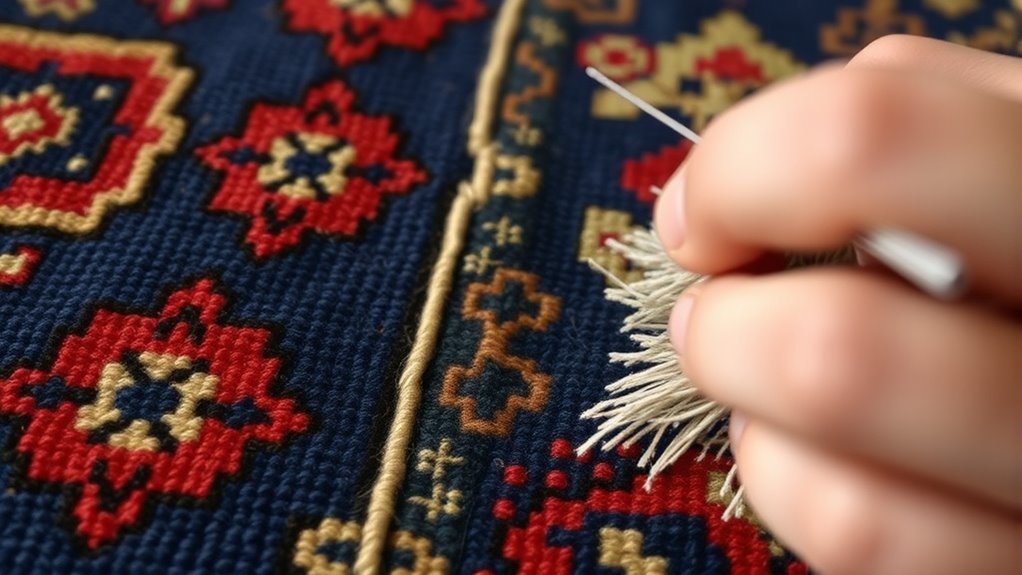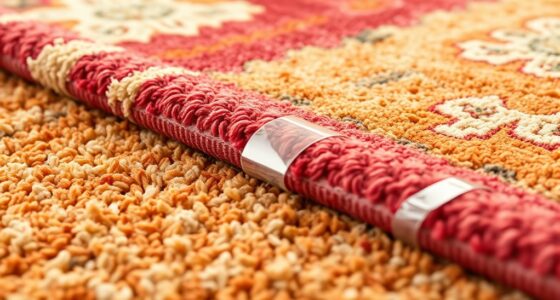Understanding the difference between rug conservation and restoration is key for collectors. Conservation focuses on preserving your rug’s original materials, integrity, and authenticity with minimal repairs, ensuring long-term stability. Restoration, on the other hand, aims to improve appearance and repair damage, sometimes altering the original features. Both have advantages depending on your goals. To protect your investment and preserve your rug’s story, knowing which approach suits your needs is essential—more details will help you decide wisely.
Key Takeaways
- Conservation preserves the rug’s original materials and appearance, focusing on minimal intervention, while restoration involves more extensive repairs and aesthetic improvements.
- Conservation maintains authenticity and signs of age, supporting long-term value; restoration may alter original features for visual appeal.
- Techniques like knot repair and dye stabilization are common in conservation, whereas restoration might include replacing missing sections or reweaving.
- The choice depends on the collector’s goal: valuing historical integrity favors conservation, whereas enhancing aesthetics leans toward restoration.
- Proper professional conservation ensures longevity and preserves the rug’s value, whereas DIY repairs risk damage and devaluation.
Defining Rug Conservation and Its Core Principles
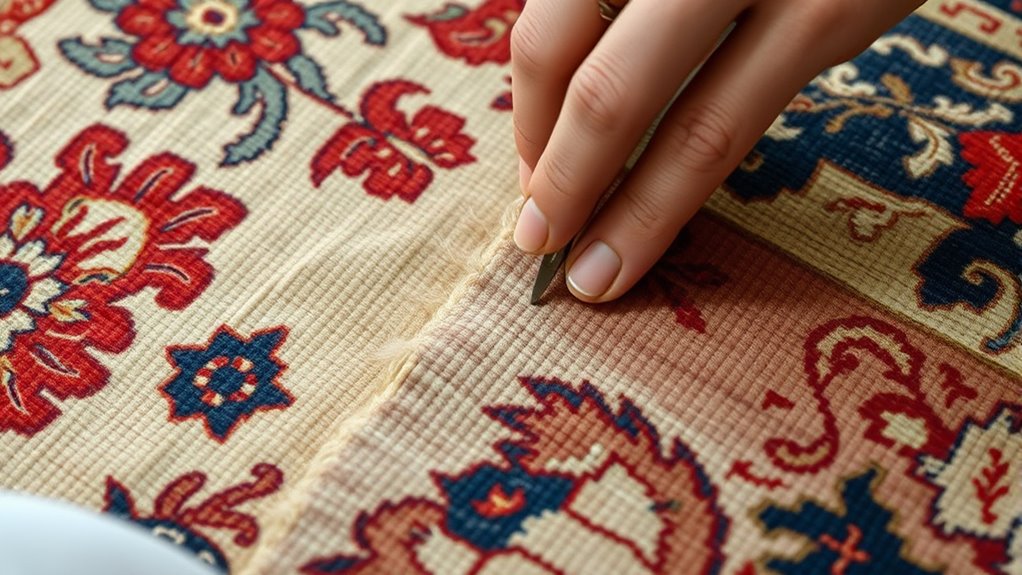
Rug conservation is a specialized practice focused on preserving the integrity and historical authenticity of rugs for the long term. Your goal is to maintain fiber integrity, ensuring the materials remain strong and durable over time. This involves careful cleaning, minimal intervention, and using techniques that respect the rug’s original construction. Aesthetic preservation is also key, meaning you protect the rug’s visual appeal without altering its character or artistic value. Conservation prioritizes safeguarding the rug’s historic significance rather than making it look new. By adhering to these core principles, you ensure that the rug’s story remains intact for future generations, balancing preservation of original materials with the rug’s cultural and aesthetic importance. Additionally, understanding the materials used in rugs helps inform appropriate conservation methods to prevent deterioration.
Exploring Rug Restoration and Its Techniques
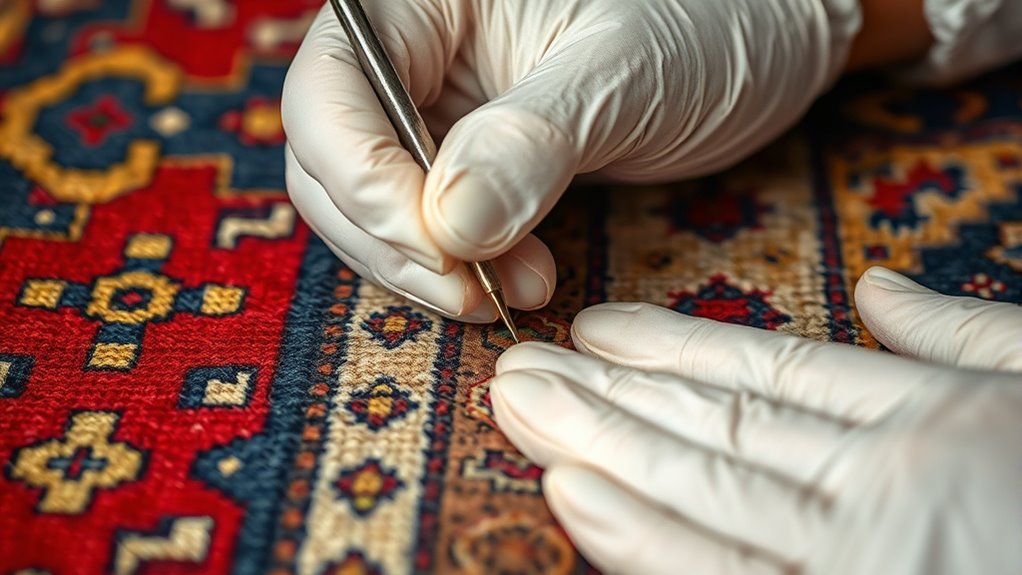
When a rug has suffered significant damage or deterioration, restoration becomes essential to bring it back to its original appearance and structural stability. Restorers start by evaluating the damage, then focus on techniques like knot repair to replace missing or broken knots, ensuring the pattern remains intact. Dye stabilization is also vital; it involves treating faded or bleeding dyes to prevent further color loss and match the original hues. Skilled restorers may carefully reweave sections, tighten loose warp threads, and reinforce weak areas. These techniques help preserve the rug’s integrity while respecting its historical and artistic value. Restoration requires not only technical skill but also an understanding of cultural significance, as this ensures the preservation of the rug’s historical context and artistic integrity. Restoring a rug requires precision and expertise, ensuring the piece maintains its beauty and durability for years to come.
Comparing the Goals and Outcomes of Both Approaches
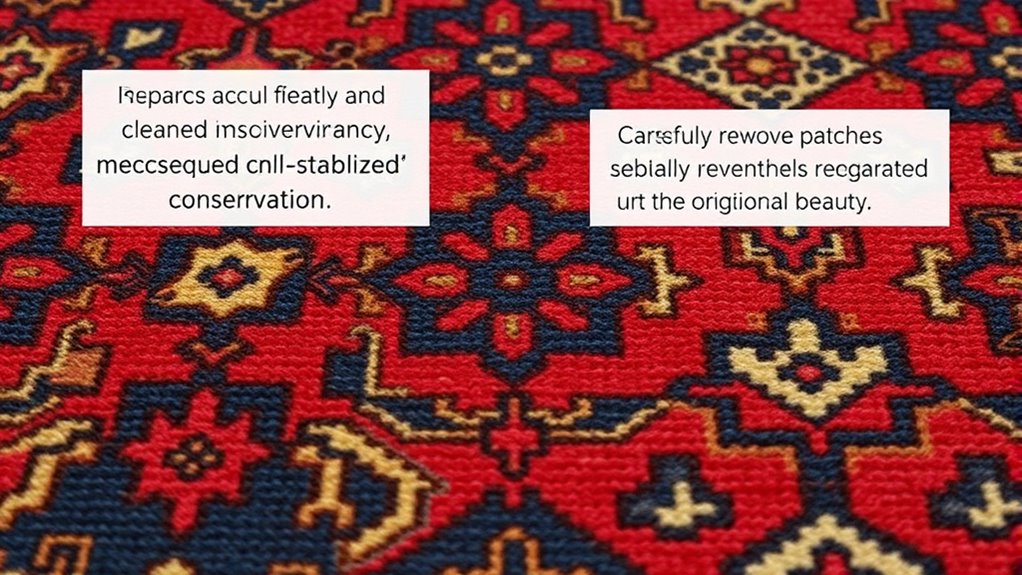
While both conservation and restoration aim to preserve the aesthetic and structural integrity of a rug, their goals differ markedly. Conservation focuses on maintaining the rug’s original state, respecting its history and cultural significance. It emphasizes minimal intervention, ensuring that any work done aligns with ethical considerations and does not compromise authenticity. Restoration, on the other hand, seeks to improve appearance or stabilize damage, often involving more extensive repairs. The outcomes of conservation are typically subtle, preserving patina and signs of age that tell the rug’s story. Restoration can sometimes alter or replace original materials to achieve a desired look. Additionally, understanding the different techniques used in each approach can help collectors make informed decisions about their rugs. Your choice depends on whether you prioritize preserving the rug’s true history or restoring its visual appeal, all while respecting its cultural significance.
Factors to Consider When Choosing Between Conservation and Restoration
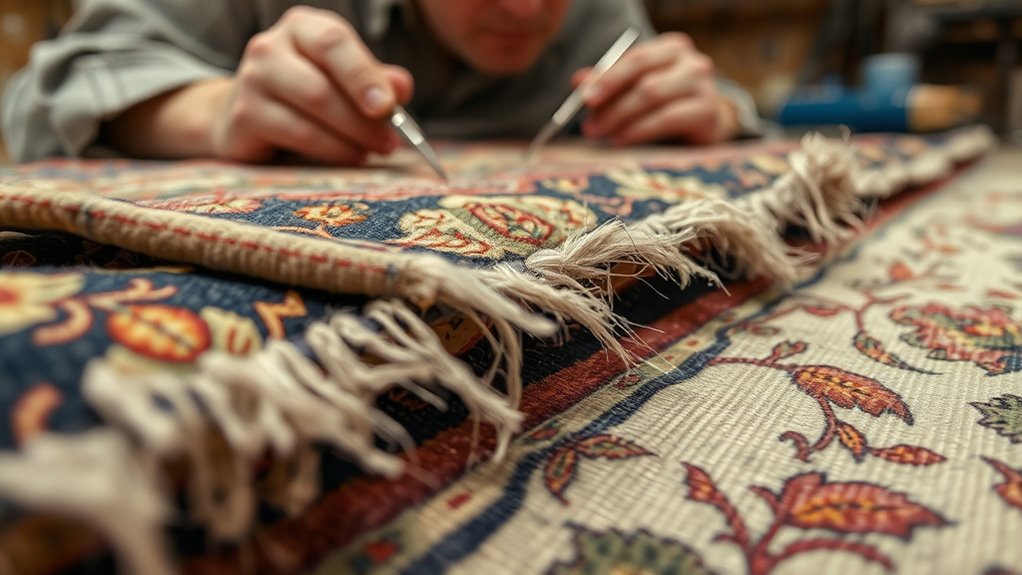
Choosing between conservation and restoration depends on several key factors, including your goals for the rug’s longevity, appearance, and historical integrity. If maintaining dye stability is essential, conservation is often preferable, as it preserves original dyes without alteration. Restoration may involve re-dyeing or reweaving, which can affect dye stability over time. Cultural authenticity also plays a crucial role; if preserving the rug’s original craftsmanship and historical character matters most, conservation ensures minimal intervention. Conversely, if you seek a visually revitalized piece that aligns with modern aesthetics, restoration might be suitable. Ultimately, evaluating how much you value original materials versus appearance and long-term stability will guide your choice. Consider these factors carefully to guarantee your rug’s preservation aligns with your intentions. Additionally, understanding pimple patches can be helpful when managing skin concerns that may affect your overall presentation and confidence.
Long-Term Implications for Rug Preservation and Value

Long-term preservation and value of a rug hinge on the approach you choose today. Opting for conservation maintains authenticity preservation, keeping the rug’s original integrity intact. Restoration, however, may enhance aesthetics but risks altering authentic qualities. Consider this table for clarity:
| Approach | Impact on Authenticity | Long-Term Value |
|---|---|---|
| Conservation | Preserves original | Maintains collector value |
| Restoration | Can alter original | May boost aesthetic appeal |
| Professional Care | Ensures longevity | Protects investment |
| DIY Repairs | Risk of damage | Short-term fix |
| Regular Maintenance | Sustains condition | Preserves worth |
Choosing wisely now impacts your rug’s future, balancing authenticity preservation with aesthetic enhancement for lasting value. Regular maintenance not only preserves the rug’s condition but also aligns with proper preservation techniques outlined in conservation guidelines.
Frequently Asked Questions
How Do Conservation and Restoration Impact a Rug’S Historical Authenticity?
When you consider how conservation and restoration impact a rug’s authenticity, think about how they influence age preservation and aesthetic enhancement. Conservation aims to stabilize and preserve the rug’s original features, maintaining its historical integrity. Restoration, however, can sometimes alter the rug’s appearance or materials, which might compromise its authenticity. You want to balance preserving its age and history with improving its look, ensuring it retains its true value and story.
What Are the Typical Costs Associated With Each Approach?
Think of rug care as a journey through a treasure map—each step has its own cost. Conservation usually falls within $200 to $1,000, acting like a gentle hand that preserves history. Restoration can climb higher, from $500 to several thousand, akin to restoring a masterpiece. Your pricing strategies should reflect this, as investing wisely today guarantees your rug remains a beautiful long-term investment, blending value with preservation.
Can Conservation or Restoration Be Reversible?
Reversibility debates are central to preservation techniques, and as a collector, you should know that conservation efforts aim to be reversible whenever possible. While some restoration processes are designed to be removed or undone, others may be permanent. You need to ask your conservator about the reversibility of specific treatments, ensuring your rug’s integrity is maintained, and future preservation options remain open.
How Do Collectors Determine Which Method Suits Their Rug Best?
You should assess your rug’s condition and your goals before choosing a method. Consider dye stability—if dyes are fragile, conservation might be best to preserve original colors. For fiber durability, restoration can strengthen weak areas or replace missing parts. Think about whether you want to maintain historical authenticity or improve longevity. Consulting a professional can help you decide which approach aligns with your collection, ensuring your rug’s beauty endures.
What Certifications or Expert Credentials Should Be Considered?
When choosing experts, you should look for certification standards and solid expert credentials. Seek professionals with recognized credentials from reputable organizations like the American Institute for Conservation (AIC) or the Textile Conservation Association. These certifications guarantee they adhere to strict industry standards, giving you confidence that your rug receives quality care. Verify their experience with similar pieces, and don’t hesitate to ask for proof of their qualifications before entrusting your rug to them.
Conclusion
So, here’s the irony: whether you choose conservation or restoration, your rug’s future still depends on your care. You might think restoring brings it back to life, but it’s conservation that truly preserves its soul. In the end, it’s your decision that determines whether your rug remains a treasured heirloom or just another story in a gallery of fading memories. Either way, remember, you hold the brush—you’re the one shaping its legacy.
